The Cause for Failure in the Pursuit of Shareholder Value for Ftse 100 and S&p500 Companies
Growth of dividend income and capital are all-important aspects. They offer total return from share investment, and as expected, many investors turn to companies, which can beat the total return that is delivered by the broader market (Lang, Stulz, 2009, 144). In encouraging, and attracting investors, many companies in FTSE 100 and S&P500 opted to provide their investors with total return (Leland, 2010, 1214). FTSE 100 is an index which constitutes of 100 corporations that are listed in London stock exchange . These firms are mostly referred as “blue chip organizations” and in traditional aspects, this index is viewed as a good indicator for the performance of major entities in UK perspective (FTSE, 2014, 1).
The S&P 500 on the other hand, refers to a stock market index which is based on market capitalization of top 500 organizations with common stock which are listed on either NASDAQ or NYSE. The index weighting and components are determined by the indices in the S &P Dow Jones. This index which is among the popular index is also regarded as being among the best representations in U.S stock market.
The S&P set a milestone in 2010 by realizing an intraday high of 1,576.10. In March 2013, S&P overtook its closing high level of 1,565.15 through recovery of its losses accrued from financial downturn. However, it still need to close well above the level of 2000 so as to set adjusted highs in new inflation in comparison to its first foray in 2000 which was above 1,500 level (Mckay, 2013, 4)
Majority of companies listed in FTSE100 and S and P 500 embarked on setting targets in improving environmental performance as well as shareholder value through high revenue performances. However, a closer examination reveals that the companies did not and have not actually realized these objectives effectively (Peterson, 2013, 11). Further, it has also been found that there is a high level of variation in the degree of rigor and ambition alongside missed opportunities for these companies in ensuring high returns, as well as incorporation of strategies aimed at sustainability (JeeYeon, 2013, 54).
Background
In their pursuance of shareholder value, “blue chip organizations” which are listed on the FTSE 100 have recently opted to penetrate into emerging markets in order to increase their shareholder value. However, many investors have been concerned on the potential risks associated with the venture into new markets as they expose themselves to potential crisis, and a meltdown in emerging markets. The companies poured themselves in markets such as in China, Turkey, Japan, Europe, and other countries in an attempt to benefit from the exciting development opportunities in these markets (Kay, 2011, 67).
Although some of the FTSE 100 companies have to some extent, been successful, their American counterparts in the S and P index 500 have only generated 5% in revenue from foreign markets. This translates that they have not effectively achieved shareholder values from these markets. Investors with FTSE 100 stocks, actively managed funds, and index tracking are exposed to risks that hamper business development (Jeff, 2013, 2).
This leaves investors with FTSE 100 stocks, index-tracking and actively managed funds with a much higher exposure to risks than they may think. For instance, the shares for the Diageo Company in 2013 dropped by 6% in just two days, due to slowed sales in Nigeria and China. These left investors with a feeling of being punched down for the reduced value of their shares. This resulted into Diageo being dropped from the “buy list” of Goldman Sachs and the company was downgraded to a neutral (Renshaw, 2014, 1).
Another example can be derived from Unilever, one of the companies listed in FTSE 100 stock index. This company, which deals with a broad range of products, also realized losses that were attributed to factors related to weaker currencies, and slow demands in such markets as Indonesia, Russia and Brazil. A decrease in local currencies translates that the total sales realized in the specific countries leads to few pounds being bought by shareholders in Britain(Clark, 2012, 45)
Tesco and ITV are other examples, which have suffered losses in the midst of lackluster trading especially in emerging markets, which has sent away the FTSE index from its 14-year record high. Despite the gain in U.S stocks in 2013 and the fact that most things were plummeting, the measures of S&P’s 500-index price momentum have been consistently decreasing, leading to an increased concern that emerging markets will eventually snuff out the rally. In 2013 alone, more than 170 companies in S&P 500 index traded below their regular average level. This performance was the worst for many years in accord to a data gathered by Bloomberg (Gallagher, and Associates,2011, 67).
Political instabilities in foreign markets such as in Turkey, Thailand have resulted into disappointing earnings for some companies as General electric, Apple and so on which saw the decrease in value of S&P 500 by 4.1% . According to analysts, this is the worst values since 2009. Some of the company gains that appeared smooth for some years triggered warnings from investors such as Nuveen investment, and Blackstone Group. Economic analysts have pointed out that the drop in value for S&P index in this year has been more than 10 percent since 2011 (Samuelson, 2013, 76).
The Cause for Failure in the Pursuit of Shareholder Value for FTSE 100 and S&P500 Companies
Economic Instability
Economic instability of some of the emerging markets is one of the lead causes why FTSE 100 and S&P Companies have failed to pursue their shareholder value. In particular, market worries about the weak export by China have led to weak FTSE indices being down. Although the FTSE realized initial early gains, the FTSE have experienced a downward bender, and actually taking it into a negative territory. It should be considered that China is the second largest economy and its fall will have a significant impact on FTSE firms. Asia in general has been experiencing economic instability as depicted by the Nikkei close down 155 points at 15, 120. Japan is also another country, which has experienced, and account deficit to a record high of 1.5 trn yen in January 2014. In general, the economic stability of a particular market determines the success or failure of a particular firm in the FTSE 100 indices or S&P 500 (Fair, 2012,76).
Financial market instability has particularly increased not only market but also credit risks for many companies in S&P list. According to the proprietary risk to price and corporate value scoring algorithm, both fonts have experienced an increase in risks for financial markets. Further, the market conditions have led to the sidelining of the market for both the current and future public offerings (Hershey, 2011, 98). This has also to the price performance being subdued and the initial public offering. Before standard and poor 500 experienced a downgrade, there was deterioration in the loan market. This was a s a result of consistent weak economical reports, particularly in Europe’s economic and debt crisis. The outflows from retail funds further pushed the S&P index down 4% of august 2013 (Thomson, 2014, 3).
Drop In the Value of Foreign Currencies
In recent perspectives, the speed and severity in the decrease of value for currencies in emerging markets has had a transactional impact on FTSE 100 and S&P companies. These companies are unable to raise their prices early enough in offsetting the decrease in currency value. Understanding the role of currency in the performance of international firms is a crucial aspect. In essence, the impact of currency on multinationals can be huge. One of the reasons why FTSE 100 and S&P have failed to achieve their targets is that they didn’t pay they didn’t pay a closer attention on managing the fluctuation and uncertainties of foreign currency (Snowdon, 2012, 76).
More than half of their sales for S&P 500 and FTSE companies are generated outside U.S. For any multinational organization, currencies can influence the business performance in a number of ways. These impacts can be in various ways such as (a) exposure in translation, where an organization converts its revenue for foreign destinations to its home currencies. B) Exposure in transaction, where prices that have been received or paid out for goods are influenced by currency and. C) Economic exposure, whereby, the input costs, cost of the goods sold, competitive advantage and the values in the balance sheet are affected (Garner, 2009, 56).
For companies that are based in America, a strong dollar in their home country, particularly during the reporting period can affect the businesses negatively. This due to the fact that revenue from forein nations may be valued lesser in comparison to the dollar at that time . Stated differently, the units of foreign currency denominated revenue will be exchanged for lesser dollars when it is translated in reporting financial results (Alan, 2009, 134).
Examples of companies that have experienced losses due to the impact of currency value include the Pfizer among others. In spite of the fact that there are companies, which thrive amidst the weak dollar, many companies in the FTSE 100 and S&P listings experienced losses probably due to ineffective currency strategies. Approximately 25% of large organizations that have exposed themselves to currency risks did absolutely nothing to edge it out. These points to the reason why many of them failed to achieve their objectives.
How Unemployment Caused Poor Performance for FTSE100 and S&P 500 Firms
Economic analysts, expert commentators and the business media have occasionally cited the high rate of unemployment in U.S as an aspect, which depicts the stock, and economic market health. In general, a drop or rise in the rate of unemployment is either good or bad for stocks. When the U.S markets had been showing significant improvements, investors and companies found themselves confronted by major obstacles. In essence, there can be no company, which has been immune from the effects of unemployment in economic perspective. There are various ways by which, negative job reports affected FTSE 100 and S&P 500 companies. This is because it directly affects the economy of a country in general. Unemployment issue had been so broad and continue to be so to an extent that some investors so it better to capture the entire economy through buying stock from such companies as DIA or SPY (Izzo, 2014, 2).
How does the rate of unemployment really affect S&P 500 as well as FTSE 100? The rate of employment is significant for the government’s short-term interest action rate. Further, it also affects in one way or another stock markets, and investors. The logic behind this aspect is that as people lack, or loose jobs to earn income from, their spending is decreased, and therefore, business would not sell much, and would realize a low return rate. Unemployment rate is can hence be related to the performance of the stock market. Essentially, the monthly employment report is a good indicator of the nation’s economy.
Another aspect on the contribution of the high unemployment rate to a company performance is that people generally do not have money to spend in comparison to an economy where majority of people are employed. This means that, business organizations will not be able to make much money the same way if people were employed. In circumstances where a huge number of people have no jobs, many business organizations ether strive to survive or they have to close due to lack of selling. When many people become unemployed, the available amount of money with the public for spending becomes low. Hence, individuals will not be able to buy from companies what they actually need. This subsequently affects businesses in direct way since the profits or sales will come down (Tufte, 2010,45).
Reference List
Alan, G 2009, ‘Progress Toward Price Stability: A 1998 Inflation
Report’Federal Reserve Bank of Kansas City Economic Review, First Quarter, (84),5-20.
Clark, J. M. 2012, ‘Business Acceleration and the Law of Demand’ Journal
of Political Economy, Vol. 25, No. 1 (March), 217-235.
Edward,R 2011, ‘The Future Income Hypothesis’ The Southern Economic
Journal, 34(July), 40-52
Fair, R 2012. ‘The Effects of Economic Events on Votes for President, 1992
Update’ Political Behavior, June, 119-39.
Garner, A 2010, ‘Progress Toward Price Stability: A 1998 Inflation Report’
Federal Reserve Bank of Kansas City Economic Review, First Quarter, (84), 5-20.
FTSE, 2014, ‘UK Quarterly R’, Available
http://www.ftse.co.uk/Media_Centre/Press_Packs/uk_review.jsp
Gallagher, G. and Associates 2009, ‘GRE Economics Test(Piscataway, New
Jersey: Research and Education Association
Hershey, R 2011. ‘An Inflation Index Is Said to Overstate the Case’
The New York Times, January 11, D1 and D15.
Izzo, P 2014, ‘Chained CPI, Stocks and Unemployment, Imports’Available from http://blogs.wsj.com/economics/2013/04/08/secondary-sources-chained-cpi-stocks-and-unemployment-imports/
JeeYeon, P, 2013, ‘CNBC’. Available from http://www.cnbc.com/id/100600350
Kay, W 2012, ‘HBOS fury as EU backs Santander's Abbey bid’. The Independent London.
Lang, L. and R. Stulz 2011, ‘Corporate Diversification and Firm Performance’, Journal of
Political Economy, Vol. 102, pp. 142-174
Leland, H.E. 2013, ‘Agency Costs, RiskManagement, and Capital Structure’,
Journal of 42 Finance , Vol. 53, pp. 1213-1243
Mckay, P 2013, ‘S&P Indices Index Mathematics Methodology’, McGraw-Hill Companies
Michael, E 2011, ‘Macroeconomic Activity: Theory, Forecasting, and
Control’ New York: Harper & Row.
Peterson, R 2013, ‘Valuation and Risk Strategies’, Standardandpoors.com, McGraw Hill
Renshaw, E, 2013, ‘The Stock Market, Economic Recession and Business Cycle With an Emphasis’
Available http://www.albany.edu/cer/bc/bc_essays.html
Sommer, J 2008. ‘A Friday Rally Can't Save the Week’. The New York Times.
Samuelson, P 2011, ‘A Statistical Analysis of the Consumption Function, in
the appendix to chapter 11 of A. H. Hansen, Fiscal Policy and Business Cycles.
Snowdon, B 2012, ‘A Modern Guide to Macroeconomics(Brookfield Vermont:
Edward Elgar Publishing Company
Thomson, M 2014, ‘Lookout Report from S&P Valuation and Risk Strategies’, Available from
https://www.capitaliq.com/media/108792-S+P%20lookout%20report%20Aug122011.pdf
Tufte, E 2010, ‘Political Control of the Economy’ Princeton: New Jersey:
Princeton University Press.








